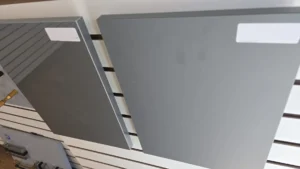When it comes to crafting furniture, the choice of wood material plays a pivotal role in determining the quality, durability, and aesthetics of the finished product. In this comprehensive guide, we’ll delve into the characteristics of Medium Density Fiberboard (MDF), Plywood, and Particle Board, helping you make informed decisions for your woodworking projects.
MDF (Medium Density Fiberboard):
MDF is an engineered wood product that transforms soft and hard wood fibers into fine particles, resulting in a dense and compact board. Here’s what you need to know:
- No Visible Grains or Knots: MDF boasts a smooth surface with no visible wood grains or knots, providing a blank canvas for various finishes and designs.
- Film Finishing Options: The board can be finished with a film that replicates any desired finish or design, enhancing its aesthetic appeal.
- Ready for Furniture Manufacturing: MDF is ideal for ready-made furniture production, offering immediate usability in crafting a variety of furniture pieces.
- Dense and Heavy: Due to its high density, MDF is heavier than particle boards, contributing to its durability and stability.
- Low Cost: MDF is a cost-effective option, making it an attractive choice for budget-conscious projects.
Plywood:
Plywood is an engineered wood product created by layering veneers and using a cross-graining technique. Let’s explore its features:
- Strong and Durable: Plywood is known for its strength and durability, making it a reliable choice for furniture construction.
- Different Thickness Options: Available in various thicknesses, plywood offers flexibility in selecting the right board for your specific project requirements.
- Veneer or Laminate Finishing: To achieve the desired appearance, plywood requires finishing with veneer or laminate before incorporating it into the final product.
- Challenging to Cut: While plywood can be more challenging to cut, its strength compensates for the effort required in shaping it for your project.
- Expensive Quality: Plywood tends to be more expensive, reflecting its high quality and suitability for long-lasting furniture.
Particle Board:
Particle Board is crafted from a mixture of sawdust, wood shavings, and resins. Here’s what you need to consider:
- Immediate Use for Furniture: Like MDF, particle board is ready for immediate use in manufacturing ready-made furniture, streamlining the production process.
- Lighter and Cost-Effective: Particle board is lighter compared to MDF and plywood, offering a cost-effective option for furniture projects.
- Top Layer Finishing: A colored film can be added to particle board as a top layer, imitating various materials such as stone, veneer, or specific designs.
- Limited Load Support: Particle board is lighter but cannot support heavy loads as effectively as MDF or plywood. Additionally, it is prone to damage if exposed to water.
In conclusion, the choice between MDF, plywood, and particle board depends on your specific project needs, budget constraints, and desired aesthetics. Whether you prioritize the smooth finish of MDF, the strength of plywood, or the cost-effectiveness of particle board, understanding the unique qualities of each wood type is crucial for achieving the best results in your woodworking endeavors.
Related blogs

An Analysis of the Advantages and Disadvantages of Different Edge Treatment Methods for Melamine Plywood
Melamine plywood, a material widely used in furniture manufacturing, interior decoration, and other fields, has

Additives Used in Plywood Glue: Functions and Benefits
Additives are essential in plywood glue formulations, enhancing the performance, durability, and environmental friendliness of

Synchro Plywood: A High-Quality Composite for Realistic Wood Finishes
What is Synchro Plywood? Synchro Plywood is an innovative composite material designed to emulate the

The 5 Best Kitchen Cabinet Materials: Pros and Cons
Choosing the right material for your kitchen cabinets is essential for both style and durability.
